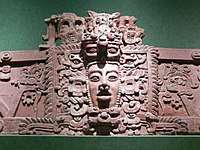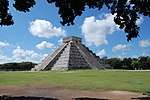Aguada Fénix
Aguada Fénix is a large Pre-Columbian Mayan ruin located in the state of Tabasco, Mexico, near the border with Guatemala. The Preclassic Maya site was discovered by aerial survey using laser mapping, and announced in 2020.[1] The flattened mound, nearly a mile in length and between 33 and 50 feet tall, is described as the oldest and the largest Mayan ceremonial site known.[2] The monumental structure is constructed of earth and clay, and is believed to have been built from around 1000 BC to 800 BC.[3]
 Aguada Fénix from the air | |
| Location | Tabasco, Mexico |
|---|---|
| History | |
| Periods | Preclassic |
| Cultures | Maya civilization |
| Site notes | |
| Condition | In ruins |
 |
| Maya civilization |
|---|
| History |
| Preclassic Maya |
| Classic Maya collapse |
| Spanish conquest of the Maya |
Discovery
The finding of Aguada Fénix was announced in June 2020 by Takeshi Inomata, an archaeologist with the University of Arizona in Tucson, who is part a research team started in 2017 called the Middle Usumacinta Archaeological Project.[4] The site is located near the San Pedro River in northeastern Tabasco.[5] It was mapped from the air and excavation begun, resulting in finds including pottery and jade axes.[6]
Characteristics
The large platform is conjectured by scientists to have been built by communal labor.[7] The clay and earth rectangular mound is a quarter mile wide and 9/10 of a mile long, and in volume reported to be greater than the mass of the Great Pyramid of Giza. Nine massive causeways and several reservoirs are components of the overall structural site, which currently is partially wooded and otherwise used for cattle ranching.[8]
See also
References
- "Laser mapping reveals largest and oldest Mayan temple". CNN. Retrieved 18 June 2020.
- Machemer, Teresa (5 June 2020). "Aerial Survey Identifies Oldest, Largest Maya Structure Ever Found in Mexico". Smithsonian (magazine). Retrieved 17 June 2020.
- Bower, Bruce (3 June 2020). "Lidar reveals the oldest and biggest Maya structure yet found". Science News. Retrieved 17 June 2020.
- Machemer, Teresa (5 June 2020). "Aerial Survey Identifies Oldest, Largest Maya Structure Ever Found in Mexico". Smithsonian. Retrieved 17 June 2020.
- "Preclassic Maya Social Transformations along the Usumacinta: Views from Ceibal and Aguada Fénix". The Digital Archaeological Record. 2019.
- "Laser mapping reveals largest and oldest Mayan temple". CNN. Retrieved 18 June 2020.
- Inomata, Takeshi; Triadan, Daniela; Vázquez López, Verónica A.; Fernandez-Diaz, Juan Carlos; Omori, Takayuki; Méndez Bauer, María Belén; García Hernández, Melina; Beach, Timothy; Cagnato, Clarissa; Aoyama, Kazuo; Nasu, Hiroo (3 June 2020). "Monumental architecture at Aguada Fénix and the rise of Maya civilization". Nature: 1–4. doi:10.1038/s41586-020-2343-4.
- "Oldest and largest Maya structure discovered in southern Mexico". The Guardian. 3 June 2020. Retrieved 18 June 2020.
